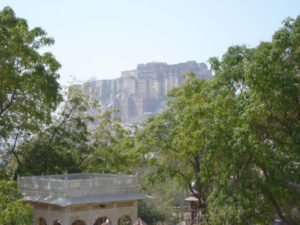Jodhpur
 Founded in 1459 AD at the edge of the Thar Desert by the Suryavanshi Rao Jodha, Jodhpur gradually grew around the towering Mehrangarh fort. Jodhpur was the headquarters of the Rathore Rajputs’ celebrations for their tales of daring. The years of peace that followed resulted in the building of palaces that were laid on open grounds and spread out in an elaborate European manner. The town was once known as Marwar, which means ‘Land of Death’, probably, referring to the harsh desert climate. It is an island of marble palaces, cordoned off from the desert by an immense wall, with eight gates facing different directions.
Founded in 1459 AD at the edge of the Thar Desert by the Suryavanshi Rao Jodha, Jodhpur gradually grew around the towering Mehrangarh fort. Jodhpur was the headquarters of the Rathore Rajputs’ celebrations for their tales of daring. The years of peace that followed resulted in the building of palaces that were laid on open grounds and spread out in an elaborate European manner. The town was once known as Marwar, which means ‘Land of Death’, probably, referring to the harsh desert climate. It is an island of marble palaces, cordoned off from the desert by an immense wall, with eight gates facing different directions.
Flanked on its western side by the Mehrangarh fort, and on the eastern side by the stately sandstone Palace of Umaid Bhawan, the monuments, temples and gardens of Jodhpur coupled with the impressive fortifield bastions, specially those of Mehrangarh which have been witness to many battles, depict a multi-faceted grandeur.
A flourishing trading centre in the 16th century, Jodhpur is still one of the leading centres of wool, cattle, camels and salt . It showcases some very fine mementoes of its glorious past – palaces, temples and other elegant monuments of architectural and historical value.
 Mehrangargh Fort: This formidable fort is among the best in India with exquisitely latticed windows in residential apartments within. Carved panels and porches, elaborately adorned walls and windows make the medieval splendor come alive.
Mehrangargh Fort: This formidable fort is among the best in India with exquisitely latticed windows in residential apartments within. Carved panels and porches, elaborately adorned walls and windows make the medieval splendor come alive.
Umaid Bhavan Palace: The only palace to be built in the 20th century, as a famine relief project which gave employment to people for 16 years. Its sculpted lawns with sandstone pavements and bougainvillea bushes, are a soothing sight in the midst of this desert city. The palace now runs as a hotel, though a part of it has been retained as a museum and part as royal residence.
